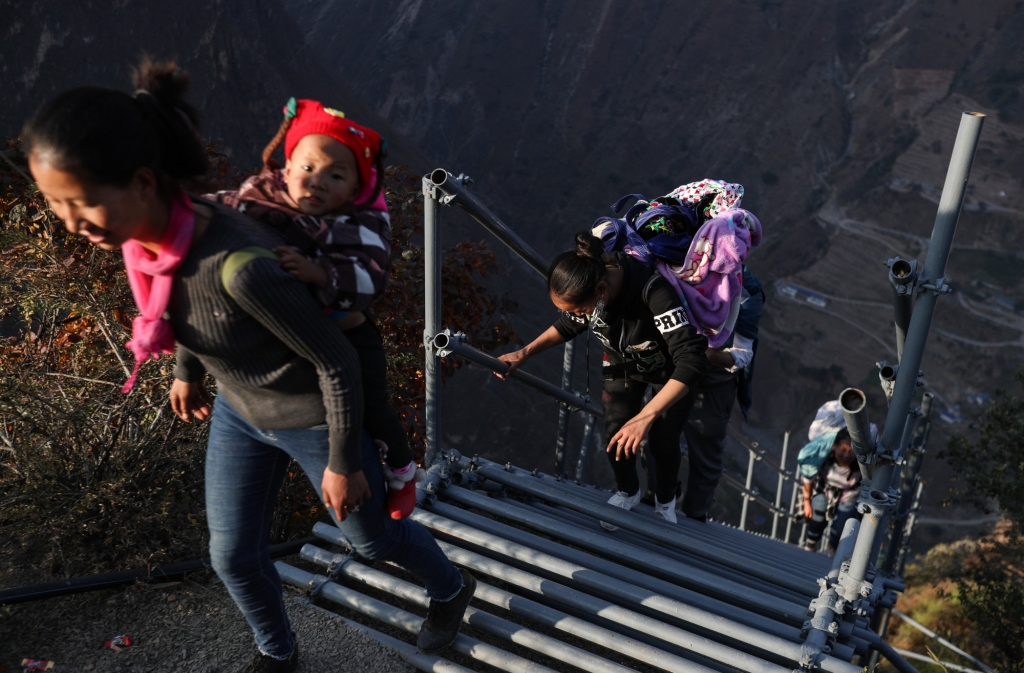Descending the ladder one last time: relocating China's 'cliff-top' villages
 0 Comment(s)
0 Comment(s) Print
Print E-mail China Focus , May 22, 2020
E-mail China Focus , May 22, 2020

China's geographical landscape plays an important role in guiding how officials administer poverty alleviation policy across the country.
Ecosystems such as wetlands, forests and deserts have all been utilized through the use of tourism, farming and the building of key infrastructure and services to help improve people's lives. But for some of China's most challenging environments, these approaches have not always been possible.
Mountainous areas cover thirty-three percent of China's landmass and account for a large proportion of its most deprived regions. According to the Outline of poverty alleviation and development in rural China (2011-2020), 10 of China's 14 most impoverished areas are mountainous and their challenging terrains have made relocation the only option to alleviate those communities from poverty.
Atule'er village, a 200-year old settlement perched on the edge of a sheer cliff face in Sichuan province, is one such place where poverty is being addressed through this method.
High in the sky but low on services
Nestled 1400 meters above the ground, Atule'er village has some of the most stunning panoramic views of China's rich countryside. But this beautiful scenery has also hindered the villages need for key services and infrastructure. For a long time, 800 meters of poorly constructed rattan "sky ladders" were all that connected the village to the outside world, and while this improved with the construction of steel ladders, commutes to school or to the local market were long, arduous and dangerous journeys.
Such limited access also had a destabilizing impact on the village's economy. While some households prospered through limited tourist opportunities, most were left behind, surviving on as little as $422 (3000 RMB) per annum.
The lack of jobs, coupled with no essential infrastructure, information technology, transports links and social services meant officials and villagers made the difficult decision to relocate a large part of the community away from the mountain in search of a better life.
Modern housing and services
On May 18, eighty-four households said goodbye to Atule`er and its steel ladders for the last time as they moved into modern living spaces in Zhaojue county, some 75 kilometres from their former home. The move coincided with the relocation of 92 other remote mountain villages from Sichuan who moved out of their restrictive surroundings in one of the largest relocation projects the province has ever facilitated.
Each household was given a fully furnished apartment ranging from 25 square metres to 100 square meter depending on the number of people. Modern kitchens, toilets, running water, electricity and gas replaced the clay huts with open fire pits that that the villagers had previously lived in.
Added to the familiar rural landscape were community centres, kindergartens, hospitals and recreational facilities—all a short walk away rather than a two-hour climb down an unsteady ladder.
"I'm very happy that today I got a very good house," villager Mose Laluo told CGTN.
"After moving to the county, life will be very convenient for my family. My children will go to school easily, and hospital services will be convenient too."
Respect for local culture
The transformation from cliff-top dweller to apartment resident was a dramatic change, and while officials were keen that their quality of life improve exponentially, they also wanted to make sure that they were prepared for such a seismic adjustment. To that end, safety education and occupancy training was organised to help the new residents acclimatise and become familiar with their new mod cons, most of which they had never used before.
Careful steps were also taken to ensure that the villagers' Yi ethnic traditions were fully preserved, with the new apartments designed to incorporate similar cultural characteristics to their former dwellings, and the opportunity for residents to continue local professions that reflected their rich history such as animal husbandry.
To ensure poverty doesn't return, the local government has begun extensive training to help find exciting professions for the new residents, which once ten industrial parks currently under construction are finished, will provide amble opportunity for them to earn a decent wage. In the meantime, 3,000 to 5,000 public welfare posts have been created to ensure that no one from the village is solely dependent on the government for welfare ever again.
Relocation from the mountain has however not applied to all of Atule`er residents. Thirty households will continue living in the village as the local government looks to expand on the village's tourism industry by building a cable cart to aid travellers those who find the ladders a daunting trek.
But for the majority of Atule'er's former residents, they now have the chance to build a new life away from the cliff-edge, safe in the knowledge that their days of living in absolute poverty are over.






Go to Forum >>0 Comment(s)